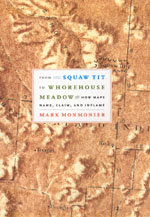An excerpt from
From Squaw Tit
to Whorehouse Meadow
How Maps Name, Claim, and Inflame
Mark Monmonier
Body Parts and Risqué Toponyms
Offensive toponyms fall into two categories. One type, examined earlier, denigrates racial and ethnic groups. The other variety, dealt with here, offends folks bothered by rude or otherwise impolite references to body parts, sex, excrement, and other no-no’s. A form of geographic cussing, rowdy feature names are markedly less controversial than their ethnically derogatory counterparts, partly because the irreverent miners and ranchers responsible for most of them avoided the F-word and similar shockers, and partly because questionable toponyms occur mostly in remote, sparsely inhabited areas with few eyebrows to raise. Indeed, an outsider who objects to a locally acceptable “naughty name” is quickly branded a stuffed shirt or prude.
Many of the risqué toponyms I have in mind seem more impish than salacious, and some are innocent victims (or beneficiaries) of society’s penchant for giving old words new, markedly different meanings. The most famous is Intercourse, Pennsylvania, named in the early nineteenth century to commemorate commerce, not copulation, but long a favorite of souvenir makers. Not far away is Blue Ball, named not for congested testicles but for the Blue Ball Tavern, an inn with a blue ball on its sign. Another Lancaster County inn, with a sign exemplifying the maxim “A bird in the hand is worth two in the bush,” inspired the name of Bird-in-Hand, a village gleefully ridiculed as a reference to male masturbation. And then there are ambiguously suggestive names like French Lick (in Indiana), a French settlement near a salt lick patronized by animals craving sodium—toponyms best avoided by list makers wary of being accused of a dirty mind. That’s my excuse for citing Lester Dingman, whose list of double entendres includes Coon Butt (in Tennessee), Bloody Dick Creek (in Montana), and Wee Wee Hill (in Indiana). Dingman served a two-year term as executive secretary of the Domestic Names Committee in the early 1970s, and his litany of titillating toponymy probably reflected colleagues’ interpretations as well as his own.
 Figure 4.1. State-level counts show a concentration of mammary-based toponyms in the West. | |
Despite these examples, the male anatomy is commemorated far less frequently than the female form because phallic landforms are comparatively rare in nature and most of the namers were men. While I found nothing else evocative of the male member in GNIS—please don’t ask what I tried—the database yielded twenty-eight feature names based on tit, an even hundred with nipple, and a handful based on teat or breast. Not surprisingly, almost all the features are summits, and few are east of the Mississippi (fig. 4.1), where the early wave of white settlers generally had stronger religious ties. The Maine coast boasts two prominent exceptions: a small island with the one-word name Nipple lies less than a quarter mile from a tiny rocky island named Virgins Breasts (fig. 4.2). Given appropriate topographic stimuli, fishermen and mariners can be as toponymically randy as miners and ranchers.
 Figure 4.2. The 1977 edition of the Jonesport, Maine, quadrangle map, published by the U.S. Geological Survey at 1:24,000, shows small islands named Nipple and Virgins Breasts less than a mile southeast of Virgin Island. | |
Some namers mixed adolescent angst with a wry sense of humor. Twenty miles east of Walla Walla, Washington, is a pair of closely spaced peaks named Milk Shakes on U.S. Geological Survey topographic maps. Although an online GNIS history note attributes the toponym to “lonely male settlers who felt [the] formations resembled breasts,” some of these settlers no doubt preferred the variant name Twin Tits. A similarly suggestive landform eighteen miles northeast of Juneau, Alaska, is unabashedly identified on a 1997 USGS map as Brassiere Hills, an appellation reinforced cartographically by the tree line surrounding the twin summit (fig. 4.3). According to USGS folklore, the name appeared on a 1948 edition of the map but was deleted from a later version because a prudish mapmaker deemed it too risqué. No less a curiosity is Maidenform Peak, a western Wyoming feature with a shape-inspired toponym commemorating a particular brand. Although the name connotes a cover-up, there’s no prudery here in rural Teton County, home of the evocatively named (if you understand Spanish) 13,770-foot summit Grand Teton.
 Figure 4.3. Brassiere Hills, as shown on the 1977 U.S. Geological Survey map of the Juneau B-1, Alaska, quadrangle, published at 1:63,630. Image is truncated on the right by the eastern boundary of the map sheet. | |
Names scholars can marvel at the commemorative meaning of nipple names, a third of which begin with a personal possessive like Elsies, Marys, Mollys, or Sadies. (The genitive or possessive apostrophe is not normally allowed because the Board on Geographic Names prefers not to show possession.) For whatever reason, Molly outranks all other honorees, with Utah alone accounting for eleven Mollies Nipple, Mollys Nipple, or Molleys Nipple toponyms. Whether a nipple feature tagged with a personal name celebrates the namee as a person or the namee’s anatomy is difficult to discern—an anatomical reference seems unlikely for Dans Nipple (in Wyoming) and Peters Nipple (in Utah). Equally intriguing is nipple’s geometrically baffling application to lakes (in Colorado and Utah), a spring (in Utah), and a valley (in Colorado). With more time on my hands, I’d enjoy delving into the history of Nipple Church, the variant name of a Mississippi house of worship now officially known as Tabernacle Church. Although the name might memorialize a steeple, it seems strangely irreverent.
A less humorous aspect of mammary toponymy is the denigration of Native American women by feature names like Squaw Tit, in its singular or plural form. Derogatory intent seems a bit obvious insofar as squaw is far more commonly paired with the mildly obscene tit than with the more numerous and clinically correct nipple. My canvass of GNIS found only two of the latter: Squaw Nipple (in Montana) and Squaw Nipple Peak (a variant for Squaw Dome, in California). By contrast, squaw is part of 19 of the country’s 28 tit-based names (fig. 4.1), and accounts for roughly equal portions of the 19 official names and 9 variants. What’s more, unlike the nipple appellations that affectionately commemorate white women named Elsie or Molly, none of the tit toponyms mentions anyone, white or Indian, by name. And of the six features with squaw variants, four still have squaw in their official name. Apparently tit was more offensive than squaw to whoever sanitized the official names of Arizona’s Squaw Butte (formerly Squaw Tit), Nevada’s Squaw Mountain and Squawtip (both formerly Squaw Tit), and Texas’s Squawteat Peak (formerly Squawtit Peak). By contrast, geometry edged out racism when features formerly known as Squaw Tit became Thimble Mountain in California and Pushtay (a Sahaptin Indian word for “small mound”) in Washington State. These subtle substitutes suggest a solution for state officials troubled by toponyms pointedly offensive to feminists and Native Americans.
A few feature names allude to what jargon-loving social scientists refer to as the sex trade. Quaintly risqué euphemisms on the cartographic landscape include Cat House Creek (in western Montana, near the Idaho border) and Pleasure House Creek, Pleasure House Point, and Lake Pleasure House (all near Virginia Beach, Virginia). GNIS lists a number of other names containing pleasure, but none particularly suggestive of a bordello. Similarly, none of the few dozen names containing hooker overtly imply prostitution, not even the two in Nevada.
The most brazen example I found is Whorehouse Meadow, a feature in southeastern Oregon, within the Steens Mountain Recreation Area, run by the Bureau of Land Management (BLM). As names aficionado Lewis McArthur reported in his 1974 book Oregon Geographic Names:
In the early days “sin” was considered an unavoidable adjunct of life in the cattle and sheep country. During the summer one or more of the female entrepreneurs from Vale would set up facilities under canvas in this accessible but secluded meadow a mile east of Fish Lake. Houses of this category, wood and canvas, passed with the end of open cattle range and all that remained was the name on the slopes of Steens Mountain. . . .
McArthur’s fondness for the bawdy toponym is apparent in his objection to its attempted erasure.
In the 1960s the BLM issued a recreation map and in deference to the moralists substituted a namby-pamby name, Naughty Girl Meadow. The USGS advance sheet of the Fish Lake quadrangle followed suit but in 1971 the [Office of Geographic Names] took strong exception to the change. As this is written, the final decision is pending before the federal arbiters. O tempora! O mores.
McArthur’s was not the only complaint. In a late 1972 story on the playful pasture’s naughty name the Washington (D.C.) Star-News reported that “folks in the Wild West wish those Puritan pencil-pushers in the federal bureaucracy would leave their colorful place names alone.”
There’s more to the story than local resistance to priggish mapmakers. According to the Domestic Names Committee case file, a USGS topographer working on the first large-scale map for the Fish Lake quadrangle visited the area in the mid-1960s and inquired locally about the feature, unnamed on existing maps. While the story of mobile madams with tent bordellos catering to summer sheepherders was hardly a secret, all informants called the place Naughty Girl Meadow, which subsequently appeared on the 1968 map (fig. 4.4, upper). The mapmaker apparently talked only to park officials, who either didn’t know or deliberately suppressed the whorehouse version. The Oregon Geographic Names Board became aware of the discrepancy in 1971, and Lew McArthur wrote to the USGS western office in Menlo Park, California. In blaming the name change on the BLM, he opined, “Life in Harney County is rougher than some more urban areas, and some facts of life are accepted without a complete and total moral condemnation.”
 Figure 4.4. In 1983 the Board on Geographic Names replaced the less objectionable name Naughty Girl Meadow, shown here (above) in an excerpt from the 1968 edition of the U.S. Geological Survey's Fish Lake, Oregon, quadrangle map, published at 1:24,000, with the original name Whorehouse Meadow, restored on the Bureau of Land Management's Steens Mountain Recreation Lands map (below) published in 1976 at 1:158,400 and enlarged to 1:79,200 in the excerpt here. | |
As reported in the USGS case file, the Oregon board complained to Washington. At its August 1972 meeting, the federal board discussed the issue but took no action. According to the minutes, “The [federal] Board has not received sufficient evidence to warrant a decision, but feels that approval of the name endorsed by the Oregon Board would not be in keeping with its general policy of not approving names which might be considered objectionable by a large segment of the public.” In an ironic reversal, the Bureau of Land Management, prudish perpetrator of the naughty girl substitute, gave Whorehouse Meadow its cartographic debut on a 1976 recreation map (fig. 4.4, lower), even though two years earlier a county map had labeled the feature Naughty Girl Meadow. In 1982 McArthur cited the BLM map in a formal proposal to the Oregon board. “All old local inhabitants agree that Whorehouse Meadow is the old and correct name,” he insisted. The state board agreed and sent a formal request to Washington, where nine months later the federal board voted “to give official recognition to a name reported to be in established local use.” As in most decisions, the federal board trusted its state counterpart and did not insist on informants’ names, affidavits, or other evidence.
Local loyalty to off-color place names is best exemplified by Dildo, Newfoundland, a small fishing village forty miles west of St. John’s. Dildo appeared on maps of the area as early as 1771, and the name is not an isolated occurrence: the topographic map covering the village also identifies Dildo Islands, Dildo Arm, and Dildo Cove (fig. 4.5). The name’s origin is obscure. Although the Oxford English Dictionary mentions a late sixteenth-century term for artificial penis (“dildoe of glasse”), it’s unlikely the original namer had in mind the shape or function of the electromechanical vibrator that was invented in 1880s as a medical device, marketed in the early twentieth century as a “personal care appliance,” and reintroduced in the 1960s as a sex toy. In 1985 Robert Elford, a villager embarrassed by the connotation, collected nearly four hundred signatures on a petition asking the provincial government to change the name. Elford, who apparently had no particular replacement in mind, backed off after neighbors who liked the name started ridiculing him in public and calling him at home.
 Figure 4.5. Dildo, Newfoundland, and related features, as shown on the Dildo, Avalon Peninsula, Newfoundland, quadrangle map (1N/12), East Half, published in 1952 at 1:50,000 by the Surveys and Mapping Branch of Canada's Department of Energy, Mines, and Resources, but reduced here to 1:56,700. | |
Diverse factors account for Elford’s failure. His initiative lacked the homophobic imperative behind the renaming of Gayside, Newfoundland (now Baytona), in 1985 or whatever anti-Soviet feeling inspired the renaming of Mount Stalin (a British Columbia landmark now commemorating Don Peck, a highly regarded local conservationist) in 1987. Local residents had few reminders of Dildo’s new, potentially offensive connotation—sex aids were not a regular feature in the news or a lingering icon of cold war rhetoric—and those with a sense of humor could delight in the salacious juxtaposition of Dildo Arm and Spread Eagle Bay (fig. 4.5). Indeed, jokes about the name were a way of being noticed, and perhaps an attraction to tourists who might stop by to mail a postcard or sample local hospitality during Dildo Days, a mid-August weekend featuring “a live band . . . enjoyable games and activities, [and] a beer tent for people 19 and older.” The long-standing name was reinforced by its identification of several nearby natural features, and the village had its own postal code (A0B 1P0), which would entail the cost and annoyance of changing one’s address. What’s more, some Dildodians no doubt felt the same sense of priority as residents of Swastika, Ontario, who resisted the provincial government’s renaming their community in 1940 to honor Winston Churchill. Defiantly they ripped down the official sign and put up a replacement proclaiming, “To Hell with Hitler. We had the swastika first.”
As with art and literature, questionable but innocent toponyms are easy prey for witch-hunts. A classic example is New York’s 1988 effort to ferret out racially derogatory names on state maps. Indignant over the label Negro Marsh (formerly Nigger Marsh) on a state wetlands map, the governor ordered that no state map may “contain any derogatory racial, ethnic or religious name or other epithet” and directed state agencies with cartographic responsibilities to “identify and eliminate problem names from all State maps.” Embarrassed that one of its maps had triggered the controversy, the Department of Environmental Conservation took a broad view of “problem names” and compiled a list of forty-five candidates for renaming. In addition to obvious foils like Nigger Pond and Jews Creek as well as names based on ambiguous words like coon and spook, the list included comparatively innocuous toponyms like Bad Indian Swamp and Christian Hill. Although the rationale for listing the latter pair was dubious but clear, the only reason for including Dingle Hole Wildlife Management Area was a willful misperception that the name referred to dingleberries, defined by Newspeak: A Dictionary of Jargon as “pieces of excrement clinging to a poorly cleansed anus.” Reluctant to get his hands dirty, so to speak, the committee official investigating suspicious toponyms responded with studiously precise bureaucratic prose.
Dingle Hole Road and Dingle Hole WMA do not appear at present to suggest derogatory intent or impact. To the Committee’s knowledge the term “Dingle” or “Dingle Hole” does not refer to any ethnic group. If “Dingle” and its variants refer to sexual behavior and/or genitalia, the Committee is not aware of that fact. “Dingle,” indeed can be easily traced to the Middle English of the 13th Century and describes a small wooded valley, a dell. A dingleberry is a shrub found primarily in the Southeastern United States. Thus Dingle Hole Road and Dingle Hole WMA may very well function as identifying names with non-derogatory intent. . . .
More blatant scatological toponyms exist, mostly as abbreviations, euphemisms, or unfamiliar spellings. Although one can speculate on the intended meaning of BS Gap (in Arizona) or S.O.B. Hill (in Utah), a GNIS history note leaves no doubt about the variant S H Mountains (now Kofa Mountains, in Arizona):
Originally named “S H Mountains” by soldiers or miners because of the similarity of lower peaks to outhouses. When ladies came into the area the interpretation became “Short Horn Mountains” in 1900.
Less oblique allusions to primitive plumbing include Outhouse Draw (in Nevada) and Outhouse Creek (in Oregon). If you wouldn’t want to drink from or swim in that stream, you’ll have no hankering for Shite Creek (Idaho), once you learn (thanks to Webster’s Unabridged Dictionary) that shite is an “obs[olete] var[iant] of
By contrast, Canadians living on Vancouver Island were more persnickety about carto-cussing, judging from successful efforts to rename Kokshittle Arm (now Kashutl Inlet) and Kowshet Cove (now Cullite Cove). Another Indian name to bite the dust is Paska Township (in Ontario)—although paska means “shallow” in Cree, the province changed the name after a local Finnish family objected that a word with a similar sound means “shit” in Finnish. Generalization is difficult, though, because the skimpy, anecdotal evidence is often contradictory. For example, Ontarians asserted a distinct preference for Crotch Lake (renamed Cross Lake in 1941 but restored in the late 1960s), while neighbors of Del Playa Park (near Santa Barbara, California), no doubt stepping lightly, disavowed the variant name Dogshit Park. Is crotch acceptably ambiguous but dogshit too offensively explicit?
Sex and feces are not the only nonracial themes to incite objections. A toponym that suggests environmental damage can provoke local residents concerned about property values. Thus, while Acid Factory Hollow might be an acceptable name for a valley in remote north-central Pennsylvania, Acid Factory Brook (now Factory Brook) was apparently too off-putting for the citizens of Kent County, Rhode Island, south of Providence. And I’ll not be surprised if advocates for people with disabilities start challenging the nation’s forty-nine Cripple Creeks as demeaning, even though these names usually commemorate injured animals. If names authorities buy their argument, look for vigorous resistance from local residents.
What’s clear is that disputes over renaming are as much about control as they are about decency, prudery, aesthetics, or compassion. The same questions arise as when groups or individuals object to racially or ethnically offensive names: who shall name geographic features, and how much clout should local residents have in selecting, defending, or expunging geographic names? Bawdy toponyms survive largely because what’s out of place in the Philadelphia suburbs fits in fine in the rugged Rockies, and because the federal board prefers to resist impulsive change and respect local tradition.
Copyright notice: Excerpt from pages 60-71 of From Squaw Tit to Whorehouse Meadow: How Maps Name, Claim, and Inflame by Mark Monmonier, published by the University of Chicago Press. ©2006 by Mark Monmonier. All rights reserved. This text may be used and shared in accordance with the fair-use provisions of U.S. copyright law, and it may be archived and redistributed in electronic form, provided that this entire notice, including copyright information, is carried and provided that the University of Chicago Press is notified and no fee is charged for access. Archiving, redistribution, or republication of this text on other terms, in any medium, requires the consent of the University of Chicago Press. (Footnotes and other references included in the book may have been removed from this online version of the text.)
Mark Monmonier
From Squaw Tit to Whorehouse Meadow: How Maps Name, Claim, and Inflame
©2006, 230 pages, 25 halftones, 17 line drawings
Cloth $25.00 ISBN: 978-0-226-53465-7
Paper $16.00 ISBN: 978-0-226-53466-4For information on purchasing the book—from bookstores or here online—please go to the webpage for From Squaw Tit to Whorehouse Meadow.
See also:
- All of our books by Mark Monmonier
- A catalog of books in cartography and geography
- Other excerpts and online essays from University of Chicago Press titles
- Sign up for e-mail notification of new books in this and other subjects
- Read the Chicago Blog
